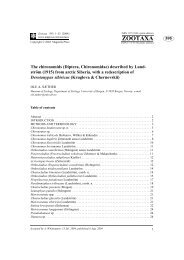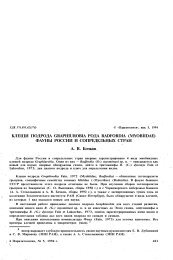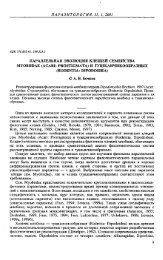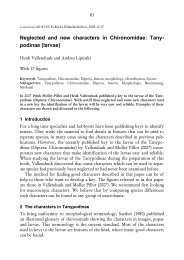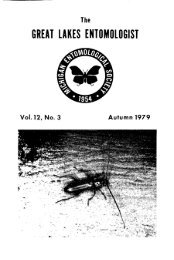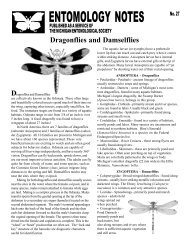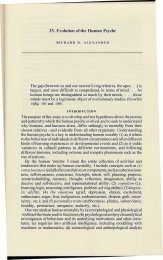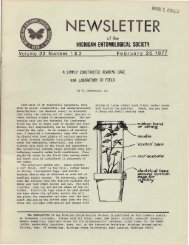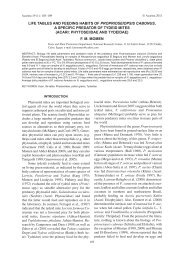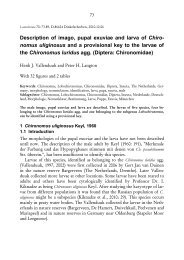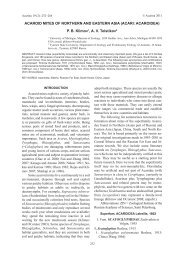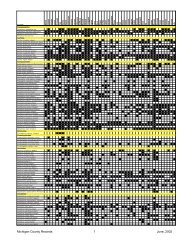Rearing and Experimenting with Isopods
Rearing and Experimenting with Isopods
Rearing and Experimenting with Isopods
You also want an ePaper? Increase the reach of your titles
YUMPU automatically turns print PDFs into web optimized ePapers that Google loves.
ENTOMOLOGY NOTES<br />
PUBLISHED AS ASERVICE OF<br />
THE MICHIGAN ENTOMOLOGICAL SOCIETY<br />
<strong>Rearing</strong> <strong>and</strong> <strong>Experimenting</strong> <strong>with</strong> <strong>Isopods</strong><br />
Have you ever turned over a rock or old<br />
board <strong>and</strong> discovered a sma I I, hard-she I led<br />
creature resembl ing a miniature armadi 1,10,<br />
<strong>and</strong> then upon picking it up had it rol I-up<br />
into a near-perfect ball in your h<strong>and</strong>? Such<br />
armoured creatures are cal led wood-I ice or<br />
sowbugs <strong>and</strong> those kinds that ro I I up are<br />
often cal led pi I Ibugs. Technically, however,<br />
they are al I known as isopods, which means<br />
"the legs ure al' ike"--of. which there are<br />
seven pairs (Figs. I <strong>and</strong> 2). <strong>Isopods</strong> are<br />
not insects but rather l<strong>and</strong>-dwel ling relatives<br />
of the crabs <strong>and</strong> lobsters. Most are<br />
rarely more than 1/2-inch long. They are<br />
excel lent subjects for indoor study because<br />
they I ive a long time, are easi Iy reared on<br />
simple fare, <strong>and</strong> react readi Iy to experiments.<br />
There are nearly a dozen species in the<br />
Great Lakes region. Two common ones are Cy<br />
Zisticus convexus (Fig. I) <strong>and</strong> Tracheoniscus<br />
rathkei (Fig. 2). CyZisticus is one that can<br />
ro I I up into a ba I I wh i Ie Tracheoniscus<br />
cannot. Another commor. species, ArmadiZZidiwr.<br />
vuZgare, has the most highly developed<br />
bal I-roll ing abi I ity <strong>and</strong> above all others<br />
deserves the name I!pillbug".<br />
Each isopod species prefers a different<br />
habitat <strong>and</strong> thus some kinds are more abundant<br />
than others in certain local ities. For instance,<br />
CyZisticus prefers a wet habitat <strong>and</strong><br />
f req uents r-ocky beaches a long streams <strong>and</strong><br />
lakes. Tracheoniscus, on the other h<strong>and</strong>,<br />
prefers twist woodl<strong>and</strong>s <strong>and</strong> so warrants the<br />
name "woodlouse". AI I these species, however,<br />
can be found in cities where they are<br />
readi Iy collected in gardens, along house<br />
foundations, <strong>and</strong> sometimes in basements.<br />
Although these animals are common, you<br />
rarely see them in the daytime because they<br />
prefer dark, moist places--under rocks,<br />
boards, bricks, <strong>and</strong> debris. Only at night<br />
do they emerge <strong>and</strong> w<strong>and</strong>er about. Then you<br />
can easi Iy find <strong>and</strong> collect them if you are<br />
armed <strong>with</strong> a flashl ight <strong>and</strong> jar. You can also<br />
trap them usinS a whole potato as bait.<br />
To make the trap, simply bore a 3/4-inch<br />
diameter hole through the potato lengthwise<br />
<strong>and</strong> then close up one end of the hole <strong>with</strong> a<br />
smal I pi ece of the potato plug. Place the<br />
b--_________________________________ _<br />
IND. 3<br />
"trap" in the garden or any other place where<br />
isopods are abundant <strong>and</strong> cover it <strong>with</strong> leaves.<br />
Let it remain there a few days. The isopods<br />
will come <strong>and</strong> feed inside the hole in the<br />
potato. To remove them, place the opening<br />
over a jar <strong>and</strong> strike the potato to dislodge<br />
them. The potato trap is especially useful<br />
for collecting smal I or young isopods <strong>and</strong><br />
rare species too.<br />
Colonies of one or more species can be<br />
easi Iy reared indoors in a terrarium. A<br />
suitable vessel should be at least 12 inches<br />
long by 8 inches wide by 8 inches high so as<br />
not to crowd them <strong>and</strong> to faci litate observing<br />
their habits. Fi I I the bottom <strong>with</strong> pulverized<br />
soi I about I-inch deep <strong>and</strong> moisten<br />
it <strong>with</strong> a Iittle water. Place a few dry<br />
leaves, twigs, <strong>and</strong> pieces of bark on top.<br />
Add one or two smal I flat stones--supported<br />
by pebbles in such a way as to leave a small<br />
space beneath for the isopods to hide. Put<br />
a tightly folded paper towel soaked <strong>with</strong><br />
water in the corner on the soi I to give the<br />
isopods some water to drink <strong>and</strong> also to<br />
raise the humidity in the terrarium. Then<br />
place two or three smal I sl ices of potato or<br />
potato peels on the soi I for food. A slice<br />
of raw carrot or some lettuce wi I I provide



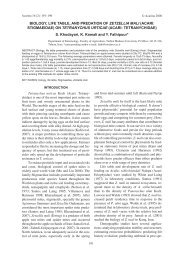
![Williamsonia 1-1 [v4.0] (DR) - Insect Division - University of Michigan](https://img.yumpu.com/18248489/1/190x245/williamsonia-1-1-v40-dr-insect-division-university-of-michigan.jpg?quality=85)
